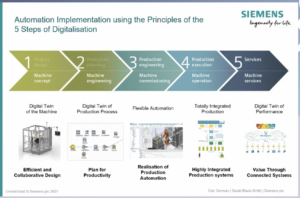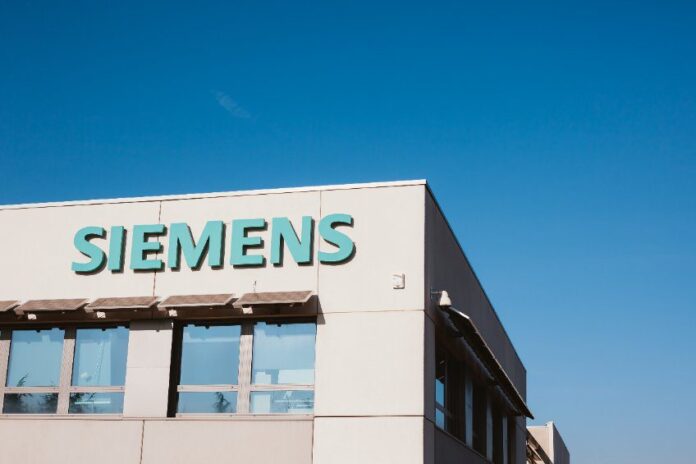Building upon its lean heritage and by avoiding the mistake of digitalizing and automating wasteful or inefficient processes, Siemens transformed its factory in Congleton, U.K. into a sustainable, make-to-order factory, where customer orders are automatically obtained and pushed through to the factory floor for manufacturing. At the Private Networks Forum, two Siemens executives detailed how the company used advanced tools like digital twins and automation to achieve this notable step change in productivity.
As Sarah Black-Smith, Siemens general manager of motion control and head of factory operation, explained early in the discussion, the company prioritized running lean and efficiently as far back as 2008 when the financial crisis hit, a priority that lasted until about 2011. In 2020, she continued, the new focus became getting close to customers so as to deliver a product more aligned with what they wanted. This, she said, was to address the flat growth it was experiencing at the Congleton factory.
The answer here, she continued, was found in advanced manufacturing tools like robotics, 3D printing and automation. “Things we weren’t really engaged with,” she acknowledged, “that was really a step change in productivity for us.”
The five steps of digitalization

Diving deeper, Carl German, strategic lead of innovation in products and processes at Siemens Digital Industries, shared the five steps of digitalization that the company coined several years ago: Product design (machine concept), production planning (machine engineering), production engineering (machine commissioning), production execution (machine operation) and services (machine services).
Using the case study of automating the process of producing and packaging a particular product at the Congleton facility, which required the design and production of a new machine, German stated that the goal was to apply “simulation models and processes wherever we [could].”
German then walked through the previously outlined digitalization steps to this journey, beginning with the digital twin concept for the product design step, saying that modeling a new machine virtually allows for more efficient collaboration. “There is no better way to facilitate [collaboration] then using digital tools and digital modeling,” he claimed, adding that digital twins also reduce risk and cost associated with new machine designs because “it’s all about learning and failing in the virtually world. If you’re learning and failing in the physical world, that’s costing you time and money.”
Next, was the production planning, where German said the company used “more rich digitalization tools to simulate the factory” to better “understand the efficiency, utilization and capacity” of it. “This is really important because you can scenario test in a safe place and not make changes to your physical production flow and find out that there is something actually not quite right,” he added.
The third step — the realization of production automation — is where the true engineering of the process comes in. Here, Siemens used kinematic modeling of the actual solution, which is a mathematical description and representation of an asset’s workspace, positional capabilities and constraints.
“Again, what you can get from this is a real sense of the capabilities and the constrains and the potential problems of the solution in a virtual world, so then you can articulate that and make changes, so when you commit to the physical worked, you are very confident that what you are going to implement will be fit for purpose,” said German.
The final two steps of digitalization outlined in the presentation are really where the ‘make to order’ concept begins to emerge.
For the product execution stage, which refers to the software platform that runs the factory, Siemens’ redeployed its legacy system to make it a “highly connected ecosystem.” He continued that in the new system takes customer orders as they come in, and then, using definitions from the production engineering and R&D departments, pulls the necessary information related to factory scheduling. From there, a recipe is created, which is automatically pushed down to the factory floor where the necessary assets are mobilized to manufacture the ordered product, again automatically.
“The idea is that each [assembly] bench articulates exactly what needs to be done for that particular product order for that particular assembly bench,” German added. “It’s real-time. There is no plan B; if the network slows down, production slows down so part of our approach to this system was [asking] how can we be resilient [and] make sure that the networks… are able to support the flow of the products.”
Finally, comes service. “Data is the driving force behind everything,” stated German. “Data isn’t new… but the appreciation of data, the systems and the intelligence we can apply to data has made a difference… We viewed our core manufacturing process in this instance in terms of core assets, core processes and infrastructure, so it’s about how do we use data to maximize the value of these particular domains.”
Part of that, he continued, involves deploying cloud-based systems, as well as industrial edge-based systems. “What we are now doing is understanding the role of high speed, low latency edge within our manufacturing processes where you need to have very quick, analytical feedback on the capability of processes or decision-making capabilities.
Beyond the steps outlined in Siemens’ digitalization strategy, Black-Smith also made it clear that the workforce at the Congleton factory was another key element of the company’s forward-facing strategy, commenting, “It’s all about people. Without bringing our people and developing our culture, we’re not going to be able to deliver any of the good things for Siemens and for our customers.”

